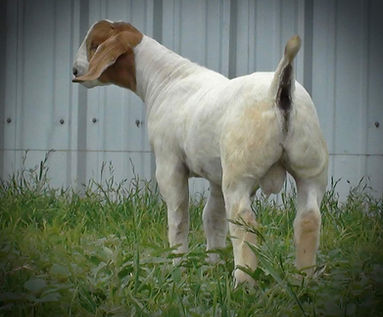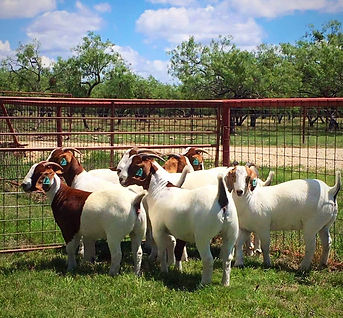Semtech ABS
Trinity Stud
Myotonic 0r Tinsley Goats
The origin of the breed.
The folk law about the early American beginnings goes something like this.
In 1880, an old man named Tinsley appeared in Marshall County, Tennessee. He brought with him a sacred cow, and four goats that stiffened and sometimes fell over if startled. He wore strange clothing and where he was from remains a mystery to this day. He worked in Marshall County for a year, then sold his goats to Dr. Mayberry. Shortly thereafter, Tinsley left one night and was never heard from again. The heavily muscled goats were later classified as a meat breed and highly prized for their muscle composition. Debbie Cassidy has written an extensive article in the American Fainting Goat Organisation, information that helps put the myotonic goat in its historical context. For a more comprehensive discription of the breed origins go to by Debbie Cassidy's article.

Fainting
THE BREED
Myotonic goats are known by many colorful names such as Nervous goats, Wooden-Leg, Fainting goats and Tennessee Meat goats. The breed carry the recessive gene for Myotonia Congenita. Myotonia acts as an isometric exercise for their muscles. The benefit of carrying the gene is that they develop powerful muscular bodies.
The term "Fainting goats" is used quite often. However it is not an accurate term to describe myotonia. Myotonic goats do not pass out or lose consciousness as fainting might suggest. Instead, they remain awake and alert through the stiffening of their muscles. However, some people still choose to refer to them in this manner. Myotonia occurs in the muscle fiber and is not as a function of the central nervous system and causes no problem for the goats.
Myotonic goats are a distinctly landrace breed, which means that they have adapted to fit the local conditions in which they evolved. Having no dairy influence and being very muscular, they are 100% MEAT goats.
There is the story that the early farmers used Myo goats in their sheep herds as sacrificial goats. The idea is if Mountain Lions or Coyote's attacck the sheep, the goats will be the first victims. There are many who doubt this colourful tale for a lot of practical reasons.
Reference Sires
Bending Tree Ranch Red Cloud
2008 buck
MGR B2600 IFGA P-86180-H

Doublejett Gomer's Sargeant
2007 buck
MGR A5227 PI 14500

S&L Farms Wyatt Earp

Henry

Ace

Sire: S&L Farms King One A1545
(by: Gowan’s Chester & Gowan’s Daisy)
Dam: S&L Farms Tundra 7537-P
These are 3 bucks back in the Pedigree of embryos and semen imported from Tennessee and surrounding States.
More information to come on these two soon.
Coyote Creek HARL Heatwave

HALR Zack

HALR Red Cajon

Cajon is a buck I am keen to recreate. He is a Grand Sire to many of the imported embyro kids. His width of chest and bone structure are that of a meat sire. If you don't have round bone for muscle fibre attachment in a sire, you can't maximise meat production.
Give me a "non feminine" doe any day over some pretty long necked show winner.
For the same purpose of making a meat animal, give me an Australorp over a leghorn any day.
When the Boer is lightly infused into the
Myotonic.
Arkansas


Yearling

Adult
IWhen they are sensibly crossed with emphasis on the Boer Breed type..
When the myotonic is lightly infused into the Boer.
Eldorado Texas.




